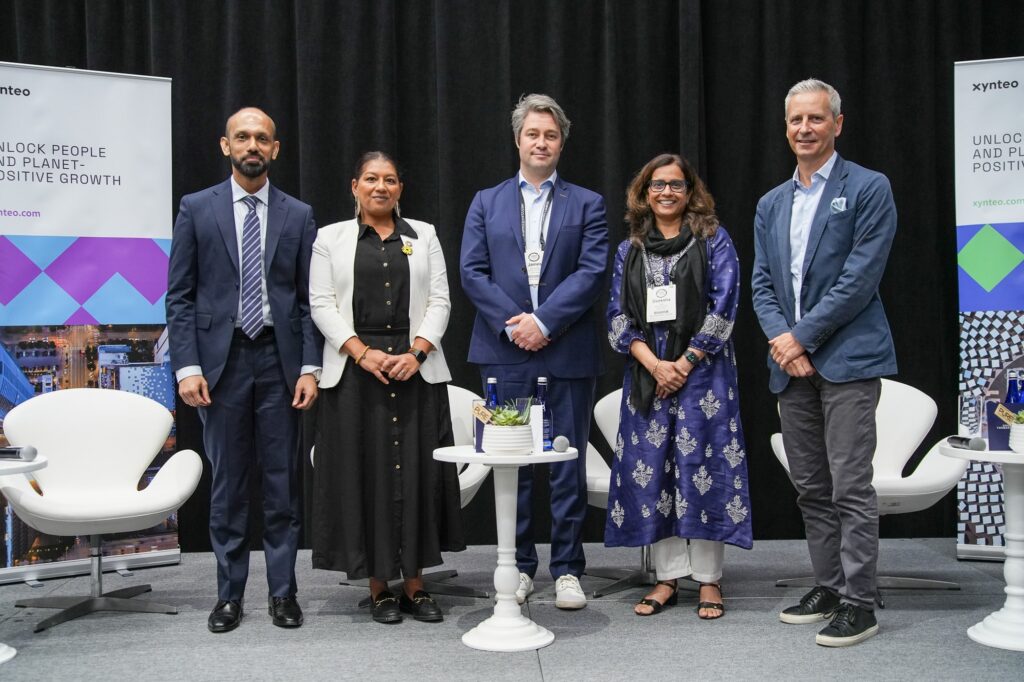The built environment, that comprises of real estate and infrastructure, accounts for 40% of global carbon emissions, necessitating urgent action to decarbonise construction and building operations, and achieve the stated objective of sectoral decarbonisation by 2050, through scalable solutions.
Given the extent of emissions created by the sector, urgent action to decarbonise our production, use, operation, and end-of-life processing of materials must be taken and scalable solutions developed. As the world grapples with the critical need to decarbonise, the construction sector finds itself in a conundrum—how do we transform our concrete jungles into sustainable ecosystems?
At Climate Week New York on 24 September, 2024, Xynteo brought together a panel of industry titans—James Drinkwater, Chair of the Investment Committee at Built by Nature and Head of Built Environment, Laudes Foundation; Guy Grainger, Global Head of Sustainability Services & ESG, JLL; Darshana Myronidis, Group Sustainability Director, Virgin; Deeksha Vats, Chief Sustainability Officer, Aditya Birla Group—for a panel discussion on “Sustainable Skylines” to tackle the complex challenge of turning a linear focused value chain collaboration into a sustainable one. Throughout the discussion, we discussed innovative approaches and successes to date as we work towards devising the solutions we need to meet key industry criteria of availability, reliability and cost effectiveness.
The role of policy in driving change
The discussion kicked off with a focus on policy’s role in shaping the future of sustainable construction, and how to navigate situations where policy lacks innovation and is not setting the right ambition. Examples of work in the EU on embodied carbon were highlighted, including the Building Life initiative, inspired by Sweden, which brings together industry players to create clear action roadmaps, and has led to EU laws on whole life carbon assessment and limits; and the Indicator Program, which unites industry, academia, and NGOs to establish benchmarks and carbon limits for new regulations. These projects demonstrate how collaborative efforts can set clear regulatory trajectories, with industry leaders now seeking more regulatory clarity to guide their sustainability efforts.
However, this led to the question. Are we waiting for policy to catch up, or should businesses seize the reins? While the panel agreed that policy leading business or the other way around was contextual, businesses have the power and responsibility to lead the way in sectoral decarbonisation, in many cases ahead of policymakers and regulators. Businesses can certainly take the lead in many situations, leveraging their expertise to drive change. Leaving it up to policymakers only, could lead to disconnects or clumsiness and would be unlikely to have the outcome you want.




Our panel of experts: Suman Jagdev (Moderator, Xynteo), James Drinkwater, Chair of the Investment Committee at Built by Nature and Head of Built Environment, Laudes Foundation; Guy Grainger, Global Head of Sustainability Services & ESG, JLL; Darshana Myronidis, Group Sustainability Director, Virgin; Deeksha Vats, Chief Sustainability Officer, Aditya Birla Group
A new paradigm for construction
While there is some traction on decarbonisation in the construction space, there’s still some distance to go. Accelerating the creation of a circular economy model within construction is key to meeting the sustainability challenge – barriers against infrastructure, customer adoption and potential of circular economy principles.
Circularity becomes more localised in terms of supply chain and stakeholders, and there is often a significant knowledge gap among planning authorities, insurers, and warranty providers for reused materials. Importantly, fit-outs are a prime area for implementing circularity, as they account for a substantial portion of a building’s whole life carbon – starting with interior spaces could create impactful and inspirational results by attracting a repeatable supply chain and providing learning opportunities, reducing waste and embodied carbon, and creating compelling narratives for users across residential, workplace, and hospitality sectors.
Finally, the importance of sending strong demand signals to the market, insurers, and planners is required so that circular economy practices in construction can lead to more appealing spaces that users are likely to occupy more, providing both environmental and commercial benefits.
Overcoming barriers to reuse and recycling
The discussion highlighted the challenges and potential solutions for increasing the reuse and recycling of construction materials – only about 1% of construction products are currently reused in Europe, with institutional barriers as a major obstacle, and initiatives such as the Circular Buildings Coalition, which addresses issues such as insurance for reused materials, was one potential solution.
Circularity, the panel agreed, should be viewed as a means to an end, such as decarbonisation and resource security, and there is a dire need for a comprehensive approach, involving supply-side solutions, demand-side specifications, and collaborative efforts to scale up sustainable practices in construction.
Retrofitting vs. new builds: What is best?
The panel also explored the massive opportunity in retrofitting and repurposing buildings, and the challenges of choosing between retrofitting existing buildings and constructing new, more efficient ones—discussing the varied policy landscapes across regions and noting that companies often set their own higher standards rather than waiting for state regulations. The context of developing countries, where growth is still a priority, must be considered and there must be a provision for more subsidies to support sustainability initiatives. Developing nations should learn from the mistakes of developed ones—so that the efficiency of connected systems in cities is increased, and the challenge of repurposing existing buildings does not seem so insurmountable.
There are 11 million empty homes globally, and while the bottom third of these are difficult to retrofit, the middle third present possibilities, albeit challenging ones. On the other hand, there is a vast number of people still lacking proper housing, and they need better design and policies tailored to local settings, rather than for unsuitable models like glass buildings ill-suited for certain climates or energy availabilities to be copied.
Enforcing sustainability as systemic change
The panel also explored strategies to enhance sustainability in construction beyond mere nudges, emphasising the need for stronger enforcement mechanisms and better accountability within industry organisations, and highlighting the importance of evolving leasehold relationships to incentivise ongoing sustainability efforts throughout occupancy. They raised about echo chambers among investors and occupiers, with hopes for radically different lease structures by 2030, advocating for universal carbon taxes and breaking down silos, factoring in cost of living and carbon costs, and suggesting stakeholder collaboration to reduce building costs.
The conversation then turned to carbon offsets, with the panel cautioning against over-reliance on offsetting, and emphasising absolute emission reductions, the need for water conservation in construction and the potential of nature-based solutions, and a balanced approach to credits and carbon sequestration. Value chains could become long-term investors in nature, with more focused lending criteria to facilitate transition to overcome the gap between transition-oriented lending and other financial products.
Looking ahead: A holistic approach to sustainable construction
The path forward for sustainable construction, as illuminated by the panel’s discussion, requires a multifaceted approach. The industry must embrace lifecycle thinking, expanding its focus beyond initial construction to consider a building’s entire lifespan, which necessitates enhanced collaboration between owners and users. Simultaneously, the vast number of unoccupied buildings presents a significant opportunity for retrofitting and repurposing, a process that must integrate insurers and value chain partners to be truly effective. Businesses are uniquely positioned to lead this transformation, often outpacing policymakers and regulators in driving sectoral decarbonisation, and while carbon offsets have a role to play in decarbonisation strategies, the industry must prioritise absolute carbon reduction and work towards more robust carbon markets. The path to sustainable skylines is challenging, but the potential rewards are enormous. It is time to build a more sustainable world, from the ground up.
You can catch up on all our Climate Week NYC 2024 insights below
Read moreStay up to date with our latest interviews by following us on social media (LinkedIn I Twitter), or Contact Us to find out how we can help your leaders and organisation create people and planet-positive impact.



